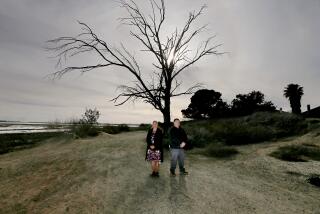Tuning In on Voices of the Past: ‘Bird Songs’ : Collection of Indian Music at Bowers
- Share via
For 2 1/2 years, Paul Apodaca has roamed throughout Southern California, tracking down and recording the region’s most unusual “bird songs.” The search has taken the Bowers Museum curator from the heart of Orange County to the rolling coast and to stark desert canyons.
But Apodaca hasn’t been hunting for secret chirps and warbles: His “bird songs” are the folk music that has been sung by Native American tribes of the region for thousands of years.
The Bowers, in Santa Ana, is featuring several of Apodaca’s recordings and videotapes as the centerpiece of its ambitious show “First Voices: Indigenous Music of Southern California,” which runs through Jan. 10. Besides the bird songs collection, the exhibit features various artifacts (pottery, tools, hunting bows, baskets, ceramic dolls), descriptive maps and photographs of the tribes.
Museum officials consider the program something of a high-water mark in their effort to focus on the region’s Indian heritage. And Apodaca, who is of Mexican and Navajo ancestry, realizes that to many people, Indian culture is still mysterious. Presenting the songs in an entertaining and comprehensive manner, he said, should provide some insight.
Many of the bird songs--so named, Apodaca said, because birds are an important Indian symbol for “the spirit and essence” of life--originated in prehistoric times and have survived pretty much intact. Usually chanted communally to the accompaniment of gourd rattles, they tell of myths and other ancient interpretations of the world and its people.
Apodaca said the repetitive, often complex melodies and one- or two-sentence refrains describe a wide range of events. Among them: the origin of animals and plants, evolution (one refrain, Apodaca said, “talks about men having tails and then losing them”), and such natural disasters as earthquakes.
“In one song we have the words, ‘There is a whistling sound under the earth,’ which we’ve come to realize is referring to an earthquake,” Apodaca said.
The songs have been used, he said, chiefly as “a way for tribal bonding, a recreation that would start in the evening and last until the sun came up. Groups could get together, and it would help them see where they were in the universe; it would help put them in their place in a very real way.”
Apodaca began his project by finding archival recordings from the turn of the century. He said that Charles Loomis, the founder of the Southwest Museum in Los Angeles, had done some pioneering work that was helpful in putting everything in context.
From there, Apodaca entered the field himself, visiting several reservations including the Morongo (near Banning), the Agua Caliente (near Palm Springs) and the Pala (near Oceanside) to meet with the Serrano, Mojave and Cupeno tribes.
He took photos and videotaped and recorded dozens of performances. “The tribe members were very responsive because they understood the importance of getting this on the record,” he said. “It was something special for me because I began to see this verbal history (unfolding). I could see the complexity of their culture.”
Apodaca believes most people are unaware of California’s large and diverse Native American community, which includes more than 200,000 people on 115 reservations. He pointed out that 32 of those reservations are in Southern California; there are about 50,000 Indians in the Los Angeles area and 20,000 in Orange County.
“It really is a sleeping giant, he said.”
Apodaca thinks it will take another three years to finish the project. He plans to recordmore songs for the museum’s permanent collection and to decipher some songs that have eluded interpretation because tribal dialects have changed extensively over time.
“It’s like putting a puzzle together,” he said. “You start by finding words that are similar (to modern words). The challenge is making sense of it all.”
“First Voices: Indigenous Music of Southern California” continues through Jan. 10 at Bowers Museum, 2002 N. Main St., Santa Ana. Museum hours are 10 a.m. to 5 p.m. Tuesday through Saturday and noon to 5 p.m. on Sunday. Information: (714) 972-1900.
More to Read
The biggest entertainment stories
Get our big stories about Hollywood, film, television, music, arts, culture and more right in your inbox as soon as they publish.
You may occasionally receive promotional content from the Los Angeles Times.










